Introduction
Agile development has revolutionized the software industry, offering a transformative mindset that prioritizes adaptability and collaboration. This innovative approach challenges traditional methodologies by breaking down projects into iterative sprints, allowing for continuous assessment and refinement. By embracing the Agile Manifesto's core values and principles, software teams can navigate the complexities of modern development with agility and efficiency.
However, despite its widespread adoption, Agile still faces challenges in larger organizations, highlighting the ongoing evolution of project management practices. In this article, we will explore the principles of Agile development, key methodologies, the importance of selecting the right approach, and the benefits of adopting an agile mindset. We will also discuss the role of continuous learning, effective communication, transparency, and the measurement of success in Agile projects.
Whether you are new to Agile or seeking to enhance your team's proficiency, this article will provide valuable insights and expert advice to help you maximize the potential of Agile development.
Defining Agile Development
Agile development transcends a mere procedural approach; it embodies a transformative mindset that has thoroughly redefined software creation and delivery. Rooted in its foundational principles and values, Agile prioritizes individuals, interactions, working software, customer collaboration, and embracing change. This philosophy emerged as a solution to the constraints imposed by traditional, sequential development methodologies like Waterfall, which frequently resulted in protracted development periods, rigid planning, and inadaptability to evolving project needs.
Emphasizing iterative development, Agile divides projects into digestible iterations or sprints. Throughout these sprints, developers focus on incremental portions of the project, fostering an environment of continuous assessment and refinement. The Agile Manifesto, a declaration penned in February 2001 by 17 software developers, encapsulates this ethos with its four pivotal values and twelve guiding principles, the most celebrated of which underscores that 'Working software is the primary measure of progress.'
Agile's iterative nature is not merely about speed but flexibility and adaptability, which often yield quicker and more effective outcomes. It is a methodological framework that parses projects into dynamic phases, allowing teams to retrospectively analyze each sprint and optimize their strategies for subsequent ones. Despite challenges such as developer burnout, changing work environments, and the advent of AI, Agile continues to offer significant advantages, particularly in its capacity to accommodate changes even at advanced stages of a project, endorsing rapid iteration—and if necessary, failure—as a conduit to project completion.
While Agile has secured a robust following, especially among smaller firms, its penetration into larger organizations remains an area of growth, as revealed in Digital.ai's 'State of Agile' survey.
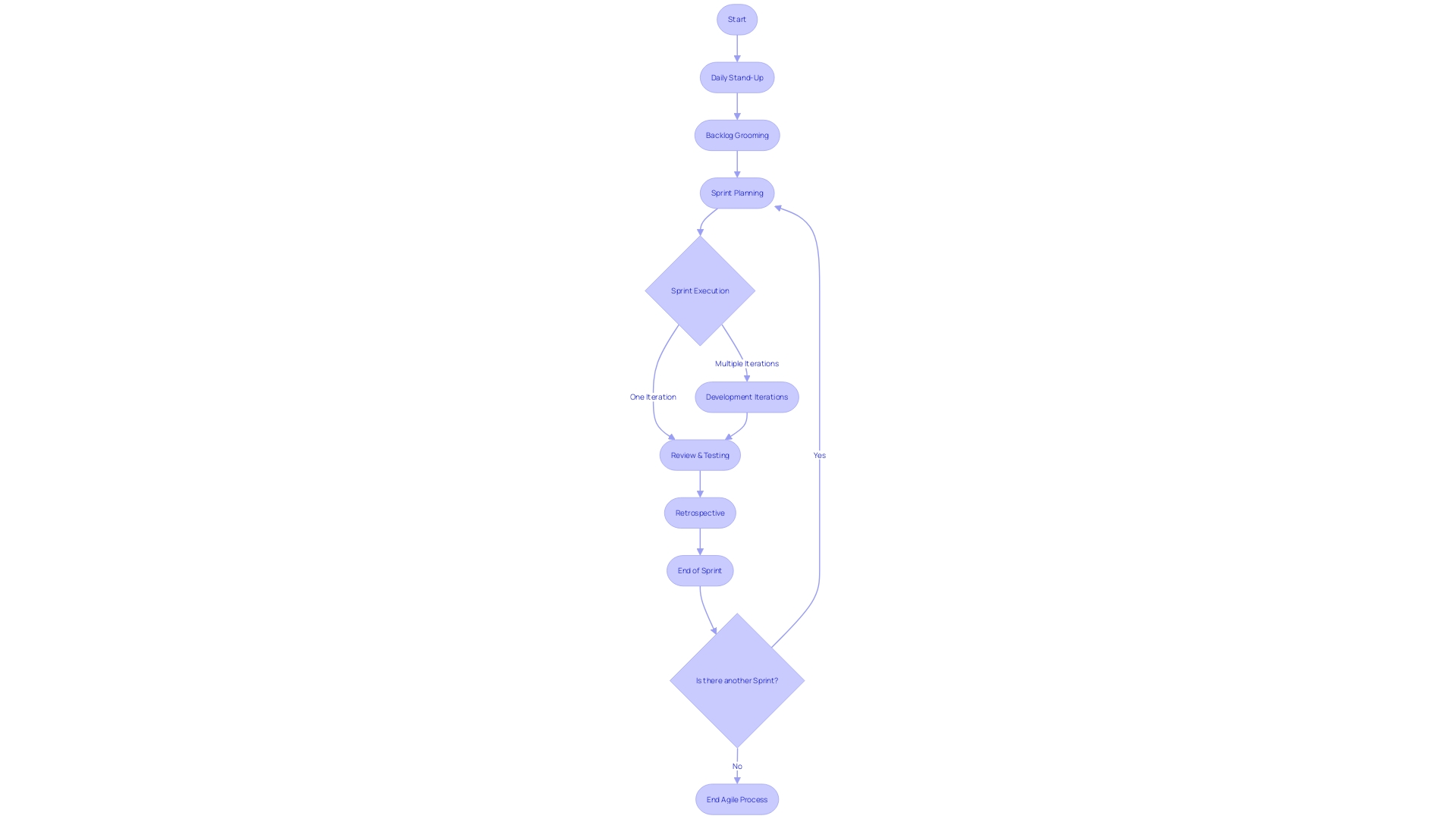
Principles of Agile Development
At the heart of agile development lies a transformative mindset, radically different from traditional software development approaches. Agile principles, including customer-focused development, embrace change, and incremental delivery of functional software, are the driving forces that allow teams to navigate the complexities of modern software projects with dexterity.
The agile philosophy centers on the belief that collaboration and flexibility are paramount. Instead of adhering to a single, exhaustive development cycle, agile promotes iterative progress through multiple cycles, fostering adaptability and continuous improvement. This approach breaks down monolithic projects into manageable sprints, with each iteration providing an opportunity to refine and recalibrate based on stakeholder feedback and evolving project dynamics.
Iterative development isn't merely a strategy; it's a commitment to delivering value at every stage. As the Manifesto for Agile Software Development famously states, "Working software is the primary measure of progress." This principle underscores the importance of producing tangible, functional results frequently, allowing teams to build momentum and maintain a sustainable pace of innovation.
Furthermore, agile's emphasis on cross-functional collaboration ensures that every aspect of a project—be it architecture, design, or development—converges towards a common goal. Agile teams are encouraged to embrace their unique strengths and passions, contributing to a project that is not only successful but also fulfilling to work on.
In essence, the agile methodology is a response to the need for speed and adaptability in a rapidly changing software landscape. It champions a culture where failures are viewed as stepping stones to success, encouraging teams to push boundaries and explore new frontiers in software development. As such, agility in software teams is not just about moving quickly; it's about maintaining balance, readiness to pivot, and a relentless pursuit of excellence in every sprint.
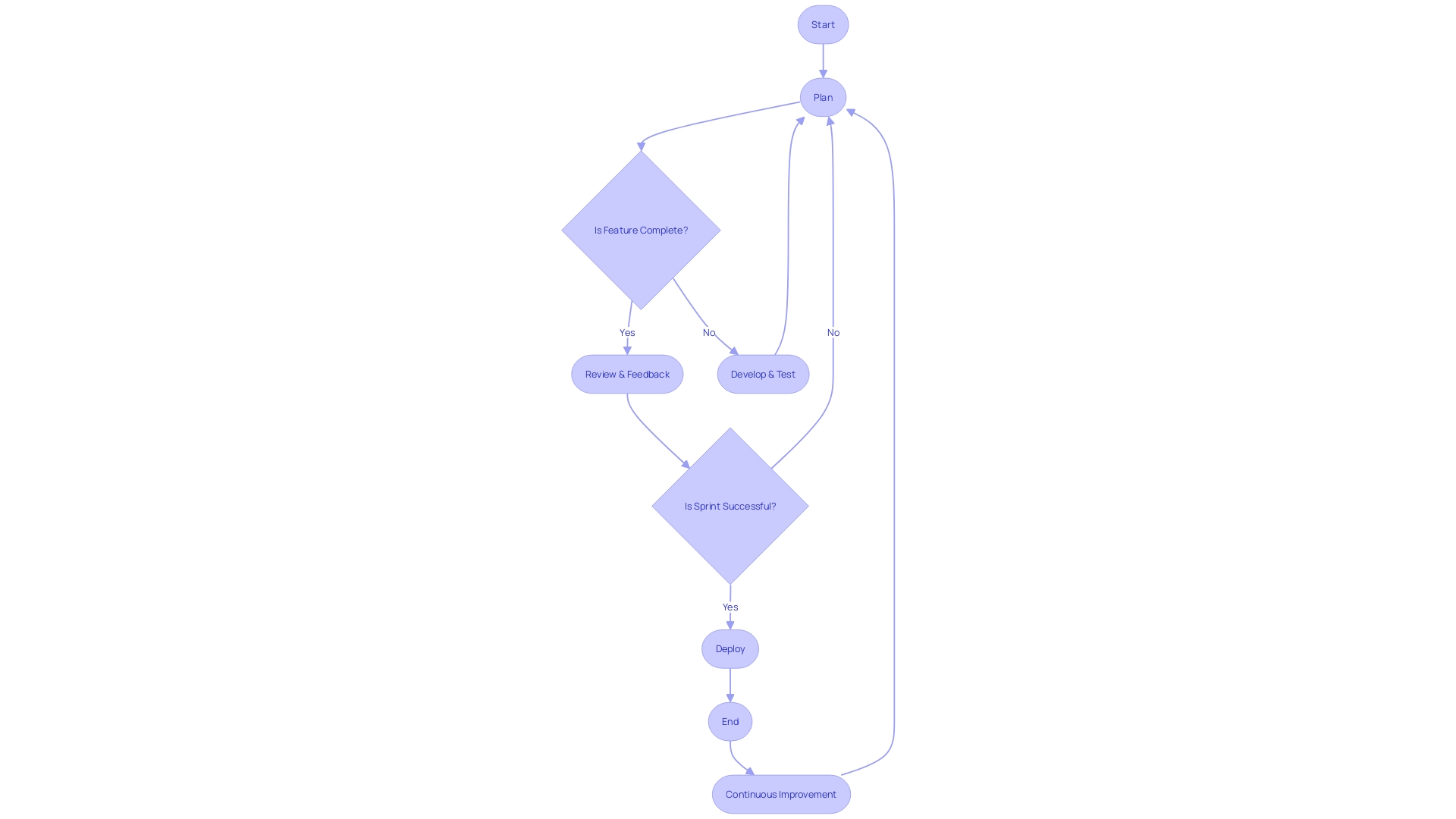
The Agile Manifesto: Core Values
At the heart of agile development lies the Agile Manifesto, which introduces four foundational values pivotal for fostering an adaptive and efficient software team. These values encourage a focus on individuals and the quality of their interactions, the significance of delivering functional software, the importance of customer collaboration during development, and the flexibility to accommodate changes even in the latter stages of the project cycle.
Agility should not be conflated with sheer speed; instead, it's about being able to adjust swiftly and effectively to new conditions, leading to more rapid and satisfactory outcomes. This principle is well encapsulated in the Agile Manifesto's first value, which emphasizes the importance of individuals and interactions over rigid processes and tools. In practice, this means empowering teams with the autonomy to make decisions and fostering collaboration, which can accelerate, decelerate, and pivot with ease while maintaining a clear direction.
Working software is paramount, as iterated in the Agile Manifesto and emphasized by the adage 'working software is the primary measure of progress.' This underscores the importance of producing tangible results at the end of each sprint, which are then used as a baseline for further development and improvement. This approach contrasts with the traditional 'waterfall' method's linear progression, which often results in inflexible plans and a product that may not meet current market needs.
Customer collaboration over contract negotiation is another core value that highlights the importance of involving clients throughout the development process. Regular feedback and open communication ensure that the product evolves in alignment with the customer's needs and expectations. This dynamic interaction can lead to more refined and user-centric software solutions.
Finally, responding to change over following a plan is a testament to the agile mindset's flexibility. This value encourages teams to welcome changes, even late in the development process, thus allowing for continuous improvement and adaptation to new insights or market demands. Agile's iterative nature, with its quick feedback loops and readiness to incorporate new ideas, makes it a robust framework for today's fast-paced software development environment.
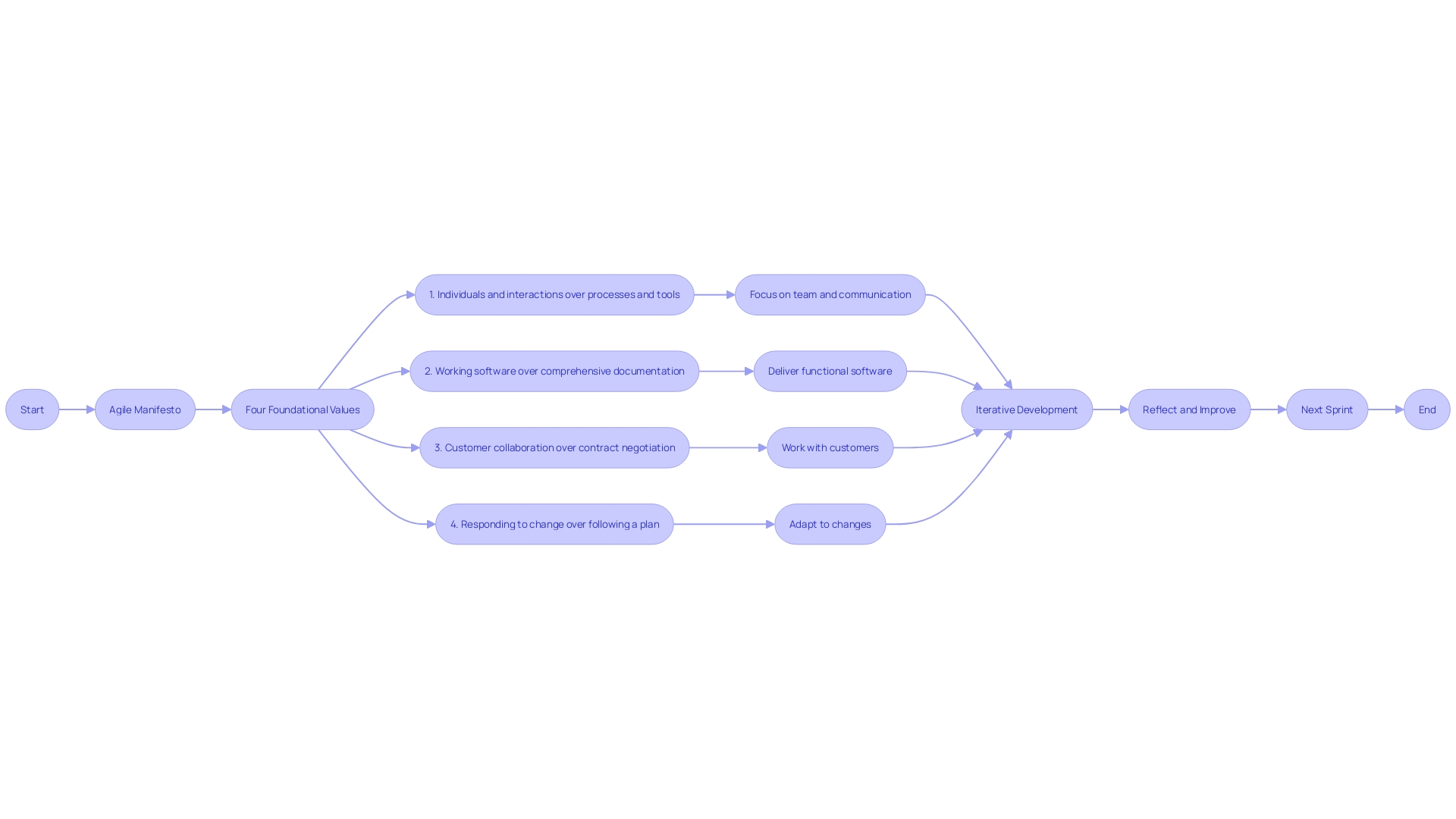
Key Agile Development Methods
Agile development methodologies, such as Scrum, Kanban, and Extreme Programming (XP), offer diverse frameworks for implementing agile principles in software teams. Scrum is a project management system that emphasizes incremental delivery, collaboration, and adaptability, according to Scrum.org. It enables teams to break down complex projects into manageable sprints, fostering continuous improvement and rapid response to change.
Kanban, in contrast, focuses on visualizing workflow and limiting work in progress, which helps teams to enhance efficiency and throughput. Meanwhile, Extreme Programming (XP) advocates for engineering best practices such as pair programming, test-driven development, and frequent releases to improve software quality and responsiveness to customer feedback.
Reflecting on the construction of the Hoover Dam, an exemplar of American engineering, which was completed two years ahead of schedule despite the Great Depression, modern software development can similarly achieve remarkable outcomes through empowerment and trust in specialists, while minimizing top-down management. The agile approach, first formulated in 2001, champions this philosophy by encouraging collaboration between developers and business executives, and welcoming changes even in the later stages of a project. This mindset contrasts sharply with the previously dominant 'waterfall' approach, which often led to inflexible planning and a higher risk of project failure.
However, agile methodologies face contemporary challenges such as developer burnout, shifting work environments, and the rise of AI. Despite these obstacles, agile remains a cornerstone of software development, as it seeks to deliver working software swiftly and efficiently, embracing the principle that 'working software is the primary measure of progress'. The success of agile in smaller firms is notable, yet its adoption in larger organizations has been met with resistance, highlighting the ongoing evolution of project management practices in the tech industry.
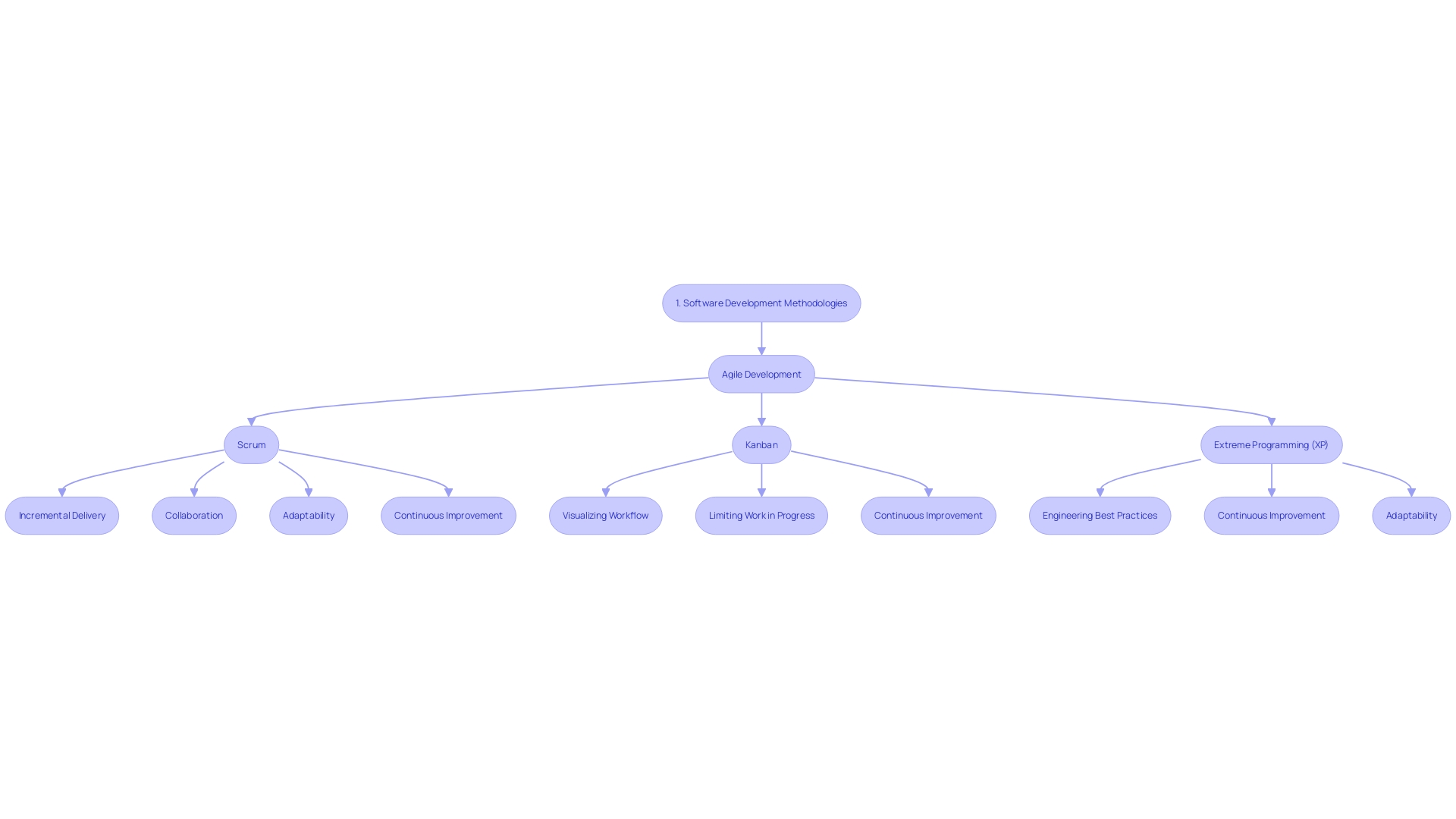
Selecting the Right Agile Methodology
Selecting the optimal agile methodology for your software development team is paramount for achieving project success. The process is not a one-size-fits-all approach; it involves an in-depth analysis of project specifics, team dynamics, and company culture. Agile methodologies, such as Scrum and Kanban, are project management frameworks that facilitate iterative development, enabling teams to deliver value faster and more efficiently.
These methodologies advocate for adaptive planning, evolutionary development, and continual improvement, all with a primary focus on keeping the customer at the heart of the development process.
Agile development hinges on the Agile Manifesto's four core values and twelve principles, emphasizing collaboration, flexibility, and customer feedback. With software development's complexity ever-increasing, agile practices have become essential in addressing the novel work that dominates the industry, where upfront specifications often give way to evolving project needs. The Agile Manifesto, conceived in 2001, revolutionized software development by shifting away from the linear 'waterfall' approach, favoring rapid iterations that accommodate changes even in the late stages of a project.
When tailoring an agile approach, it's crucial to consider the structure and size of your teams, the nature of your product, and the specific challenges your organization faces. Whether you're aligning cross-functional teams to streamline development or adjusting team compositions to suit mid-size company structures, the agile framework's adaptability is its strength. Agile methodologies also provide a structured path from project initiation to completion, defining roles, responsibilities, and the artifacts required at each stage.
Despite the increasing popularity and recognized benefits of agile, such as enhanced focus on business value and quality, many organizations encounter challenges in achieving true agility. Familiar obstacles and misconceptions can slow progress, but with the right approach, these can be addressed to ensure successful software development and delivery. Adopting agile is not merely a procedural change but a cultural shift that empowers teams to be more responsive to change and better equipped to deliver high-quality software.

Embracing a Growth Mindset
Adopting an agile mindset is more than just a shift in project management techniques; it's about embracing change and learning from every step along the way. Agile development, first conceptualized in 2001, is characterized by its iterative process that centers around rapid cycles of work known as 'sprints.' This approach allows teams to adapt quickly to new information and changing project requirements, ensuring that the end product is as refined and effective as possible.
The essence of agility lies not in speed but in flexibility and adaptability, which often results in more efficient and satisfactory outcomes. Agile teams are encouraged to work collaboratively, often with daily interactions between developers and business stakeholders to discuss progress and make necessary adjustments. This methodology fosters a 'growth mindset,' a concept popularized by psychologist Carol Dweck, which suggests that abilities and intelligence can be developed through perseverance and hard work.
For instance, Nets, a provider of digital payment solutions, faced the challenge of presenting complex technical data in an easily digestible format. By adopting agile principles, they were able to transform dense tables and schemes into engaging formats that motivated user interaction. This is a prime example of how a growth mindset contributes to the agile process, turning obstacles into opportunities for innovation.
Agility is about responding to change effectively. Statistics show that employees who perceive their company as agile are more likely to believe in its competitive edge and financial security. Agile organizations often outperform their peers, not because they work faster, but because they work smarter, learning and evolving as they go.
In a world where the tech industry faces issues like developer burnout and the need to integrate AI, Agile's principles remain robust. By upholding the value of working software over comprehensive documentation and embracing a culture of continuous feedback, agile development ensures resilience in the face of industry challenges. With the right mindset and methodologies, teams can navigate the complexities of software development, including the intricacies of Vue.js, to deliver solutions that truly meet the dynamic needs of users.

Continuous Learning and Upskilling
Agile development methodologies have been a game-changer since their inception in 2001, promoting the swift delivery of software through incremental sprints and close collaboration between developers and business stakeholders. Yet, as the technology landscape evolves with new languages and tools emerging regularly, software teams must embrace continuous learning to stay competitive. Consider the transformation from the early 2000s, where C++ and Java dominated, to the present rise of Python, Go, and Rust due to their efficiency and adaptability.
Now, with cloud computing and DevOps becoming mainstream, engineers are required to master new architectures, deployment strategies, and integrate advanced technologies like AI.
A culture of continuous learning within software teams can lead to innovation and agility—a sentiment echoed by Spotify, where a blend of formal courses and informal peer-to-peer collaboration, termed 'applied learning,' drives progress. It's not just about attending training sessions; the impact on work and alignment with organizational goals is vital, as suggested by the Kirkpatrick Model's emphasis on evaluating behavioral changes post-training. Furthermore, deliberate practice, characterized by structured tasks and actionable feedback, is crucial for mastering new skills, as highlighted by K. Anders Ericsson's research.
Real-world examples illustrate how tech giants and startups alike navigate the learning curve. Google, for instance, has grown by solving complex engineering challenges in-house, while Pinterest weighed the 'build versus buy' decision before embracing AI-assisted development. Similarly, the digital transformation has prompted many engineers to explore AI for personal projects, eagerly anticipating its integration into their professional workflow.
To harness Ai's potential, they must evaluate not only the benefits but also grapple with the legal and security implications.
In this environment of rapid technological advancement, encouraging professional development and fostering knowledge sharing become not just beneficial but essential strategies for any software team committed to agile principles.
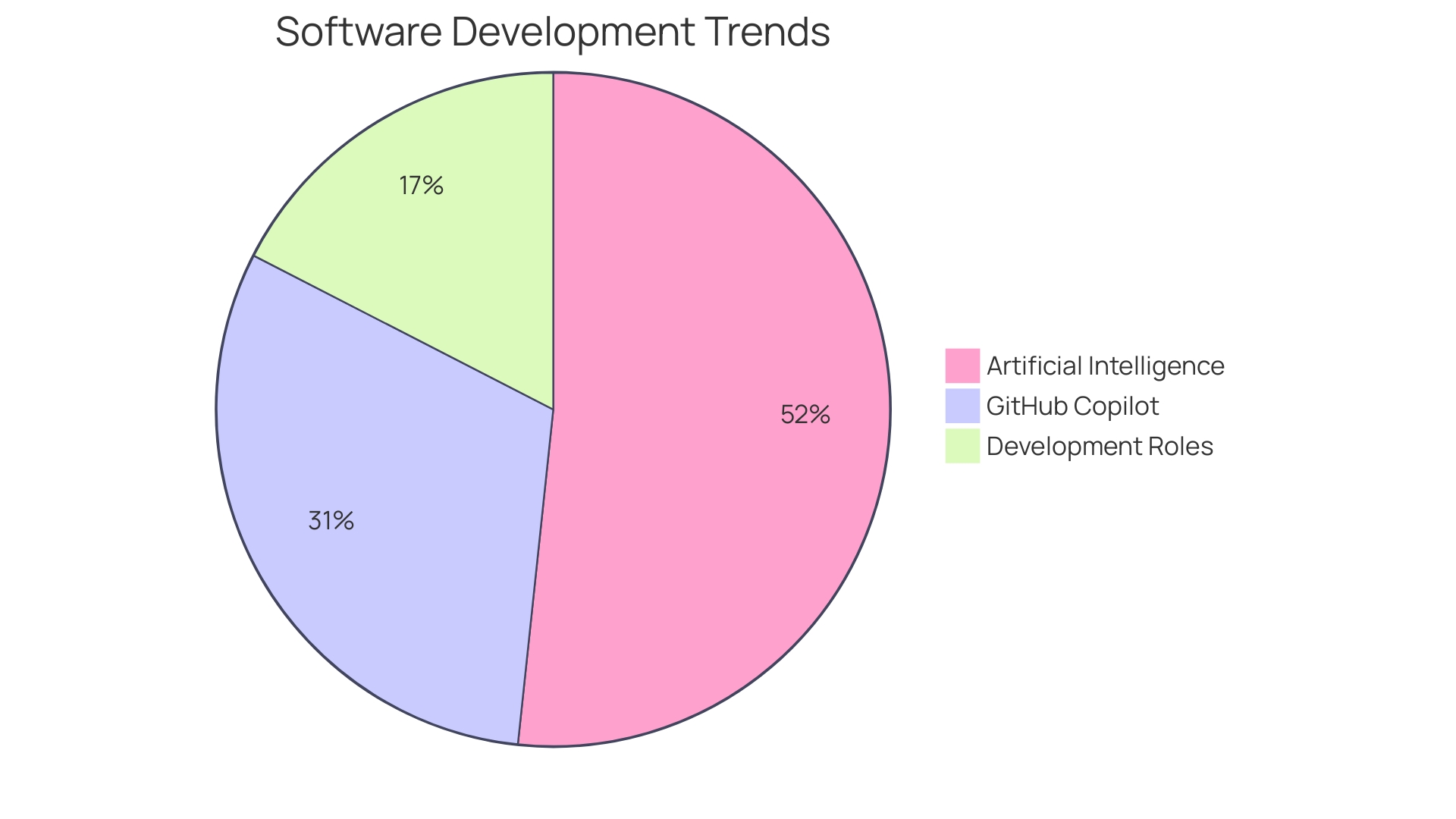
Effective Communication in Agile Teams
Effective communication is the backbone of agile development, ensuring that teams are aligned and collaborative, which is essential in the rapidly changing landscape of software projects. Agile and Scrum methodologies have revolutionized project management, emphasizing flexibility, collaboration, and customer centricity. These practices allow teams to adapt swiftly to changing customer needs and market conditions.
Adopting a cross-functional approach is vital, as it brings together diverse skills and expertise. This approach breaks down silos and fosters cohesion, enabling the team to tackle complex problems from various angles. Communication strategies such as concise openings, clear context, and well-defined outcomes are crucial for successful interactions.
For example, Nets, a provider of digital payment solutions, faced challenges in presenting technical data in an engaging way. They transformed this data into interesting formats, motivating users to explore information independently.
Agile principles recommend daily collaboration between developers and business executives. Stand-up meetings are a core practice, serving as a platform to monitor progress and adapt plans quickly. According to the JetBrains and GitKraken 'State of Git Collaboration Report', the cohesion and efficiency of a development team are instrumental to project success.
Moreover, projects with well-documented requirements before development are significantly more likely to succeed.
Metrics such as velocity, cycle time, and customer satisfaction scores are indispensable for evaluating performance and facilitating data-driven decision-making. Furthermore, active listening is an underappreciated skill that can enhance collaboration and productivity, leading to successful project outcomes.
Despite its benefits, Agile faces challenges such as developer burnout, shifting work environments, and the emergence of AI. Nevertheless, its principles remain a cornerstone of modern software development, with the Agile Manifesto asserting that 'working software is the primary measure of progress.' As such, embracing Agile practices, when implemented correctly, can lead to improved performance, faster delivery, and greater financial returns.
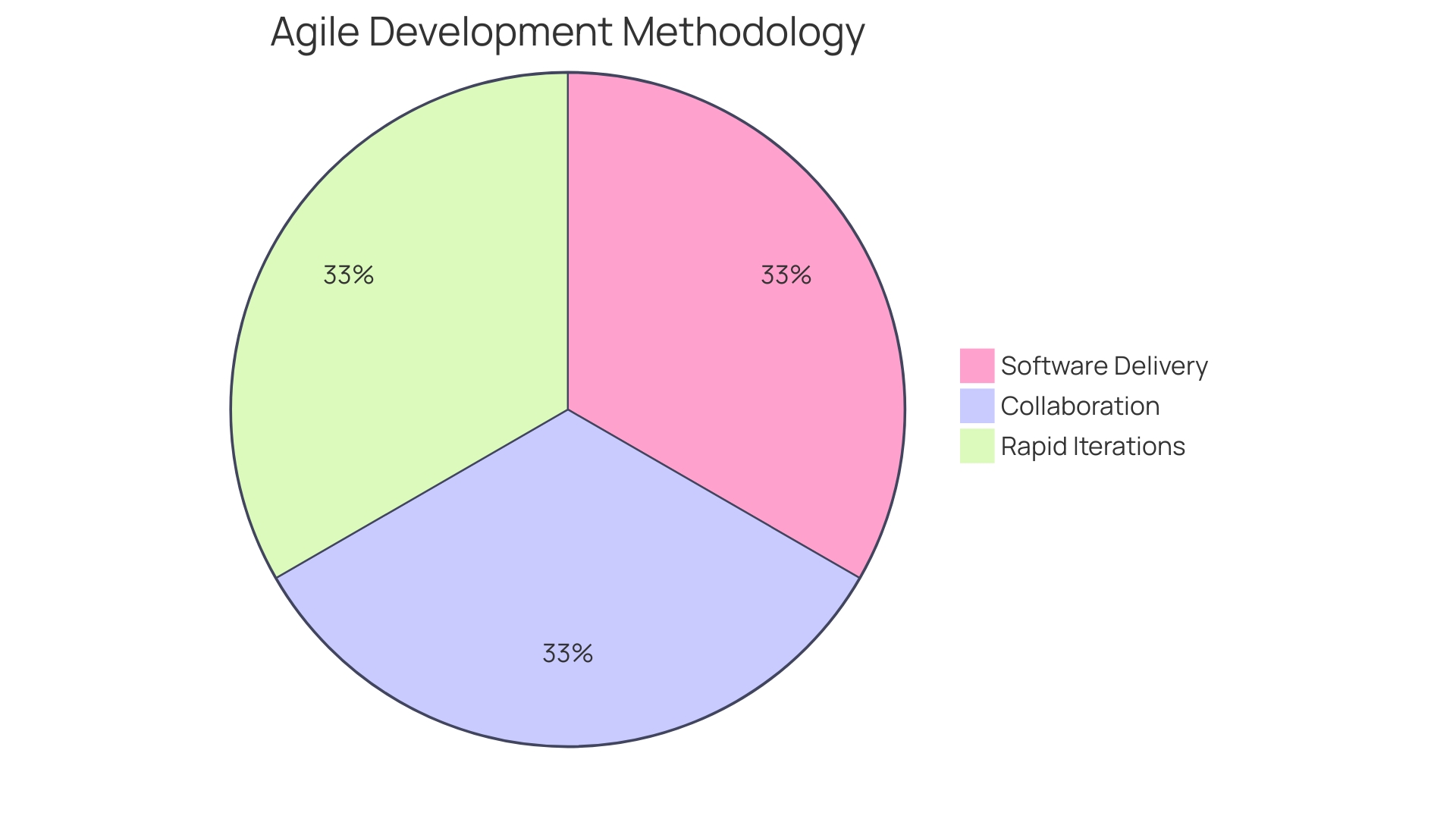
Frequent Iterations and Feedback Loops
Agile software development has fundamentally altered the landscape of project management and execution, emphasizing the necessity of iterative cycles and open feedback channels. The essence of Agile is to break down large projects into smaller, manageable units known as sprints, which are regularly revisited to ensure alignment with the project goals. The iterative approach allows teams to adapt to changes swiftly and efficiently, making certain that the end product is in sync with client requirements and market trends.
Understanding that there are misconceptions about Agile development being a single-cycle process, it's crucial to recognize that Agile actually involves multiple iterations. Each iteration is an opportunity to refine and enhance the software, drawing from continuous feedback and collaboration between developers, stakeholders, and users. This dynamic process contrasts with the traditional Waterfall methodology which often results in rigid structures and delayed responses to changes.
In light of current industry changes, including the integration of artificial intelligence in development processes, Agile methodologies face new challenges. Agile's core principle of valuing 'working software as the primary measure of progress' remains more relevant than ever. It is the ability to embrace change, even late in the development process, that defines Agile's success.
By prioritizing customer collaboration and responding to change, Agile ensures that software teams are not just building products, but the right products. As such, Agile practices are not confined to the realms of development but span across various sectors, proving their versatility and effectiveness in delivering quality software solutions.
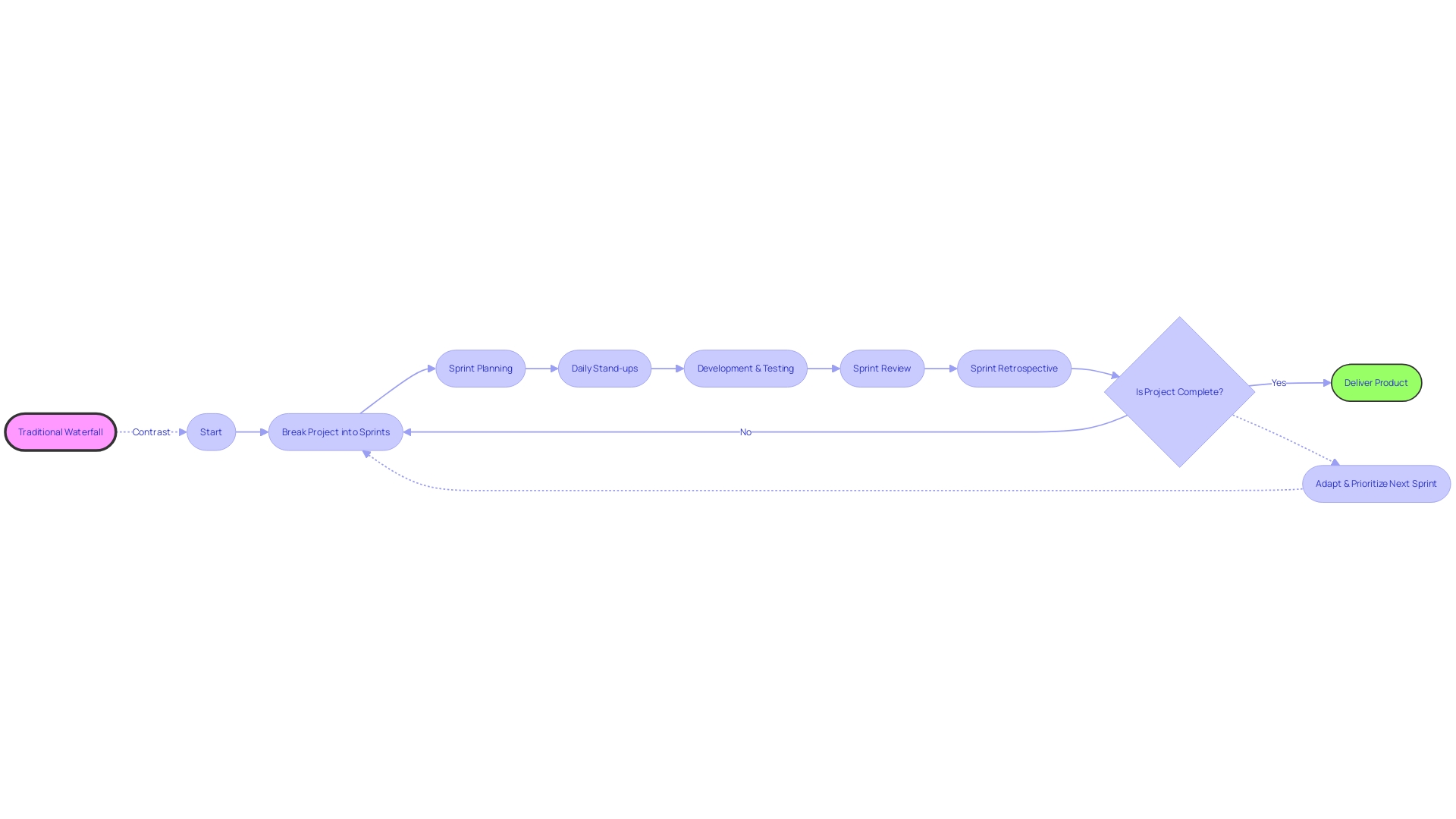
Implementing Agile Practices for Flexibility
Agile development is fundamentally about embracing an adaptive mindset that thrives on change and continuous improvement. Essential to this approach are practices such as iterative development, where projects are divided into manageable sprints, facilitating regular review and adaptation. This incremental approach ensures that the team can respond swiftly to evolving requirements, reflecting the core Agile principle that values customer collaboration and responsive change over strict adherence to initial plans.
To realize the full advantages of Agile, it's imperative to understand that it's not merely about speed but about the ability to maneuver with precision and adjust direction swiftly, which can inherently lead to more timely and satisfactory outcomes. This distinction is crucial; agility encompasses the capacity to accelerate, decelerate, stabilize, and quickly change directions with the correct posture, while speed is about moving rapidly in a single direction.
Despite the widespread adoption of Agile practices, a study involving 127 companies worldwide revealed that only 53% of those that implemented Agile methodologies achieved true agility. These companies witnessed tangible improvements such as a 15% to 20% reduction in delivery costs, two to four times faster product delivery, and a twofold increase in total shareholder return. Conversely, the remaining 47% of companies were under the illusion of agility, adopting Agile practices without reaping the full performance benefits.
In practice, adopting Agile goes beyond implementing specific techniques; it requires a cultural shift that fosters collaboration among all stakeholders, including developers and business executives, throughout the duration of a project. Daily stand-up meetings and welcoming changes even at late stages are emblematic of Agile's dynamic nature. Adopting Agile has proven to be an effective counter to the rigid, linear Waterfall model, which often results in protracted development cycles and a lack of responsiveness.
As you integrate Agile practices such as user stories, sprint planning, backlog grooming, and sprint reviews, remember that these are tools to enhance flexibility and adaptability within your team. They are not ends in themselves but means to achieve greater collaboration, faster delivery, and ultimately, products that better meet the changing needs and expectations of customers.
Promoting Transparency and Communication
Embracing transparency and open communication is a cornerstone of agile development, serving as a catalyst for effective collaboration within software teams. Visualizing project progress is a strategy that has proven its worth, as seen with one organization's initiative to establish guiding principles that emphasize the importance of maintaining clear documentation. By implementing common communication tools like chat, project boards, and pull requests, this organization was able to manage over 1,500 engineers, ensuring that everyone stayed informed without being inundated with notifications.
Sharing information through team dashboards is another method that fosters transparency. A global study involving 127 companies found that while 94% had adopted agile practices, only half were truly agile, highlighting the difference between simply adopting practices and achieving a transformative agile culture. The key to this transformation lies in continuous delivery and deployment, ensuring that software is always in a releasable state, thereby enhancing productivity and accelerating product delivery.
Regular team retrospectives are integral to maintaining an agile environment. These retrospectives allow teams to reflect on their processes, celebrate successes, and identify areas for improvement, ultimately leading to increased efficiency and innovation. A notable figure in software development criticized agile for not being conducive to innovation due to its emphasis on short-term sprints.
However, agile's focus on adaptability and flexibility can, in fact, foster innovation when teams are empowered to take calculated risks beyond the sprint cycle.
In conclusion, for teams to truly harness the power of agile development, they must commit to the principles of transparency and open communication, embracing strategies that allow for continuous improvement and a culture that supports the free flow of information.

Addressing Common Challenges in Agile Projects
As agile development methodologies like Scrum revolutionize project management, teams face challenges such as scope creep, resource constraints, and resistance to change. Agile's emphasis on flexibility and adaptability requires a dynamic approach to problem-solving. To mitigate these challenges, it's essential to foster a culture of shared responsibility and open communication.
Empowering team members by delegating authority and responsibility can help in navigating complex projects. By involving specialists in decision-making and keeping upper management's involvement to a necessary minimum, teams can harness diverse expertise and drive projects forward more effectively. Agile's principles encourage collaboration between developers and business executives, advocating for daily cooperation and welcoming changes even at advanced stages of the project.
Using metrics such as sprint velocity and customer satisfaction scores, teams can make data-driven decisions and promptly adjust to feedback, ensuring continuous progress. A cross-functional approach, where team members with varied skills work together, can further enhance the team's ability to address unexpected challenges, much like the successful completion of the Hoover Dam despite extreme weather and geological surprises.
Incorporating lessons from the Hoover Dam's project management, such as tackling unforeseen challenges with resilience and a well-coordinated team effort, can be instrumental for modern software teams. The Hoover Dam's completion ahead of schedule, despite the odds, is a testament to the efficacy of these strategies. By embracing agile principles and learning from historical engineering feats, software teams can overcome the hurdles of today's rapidly evolving tech landscape.
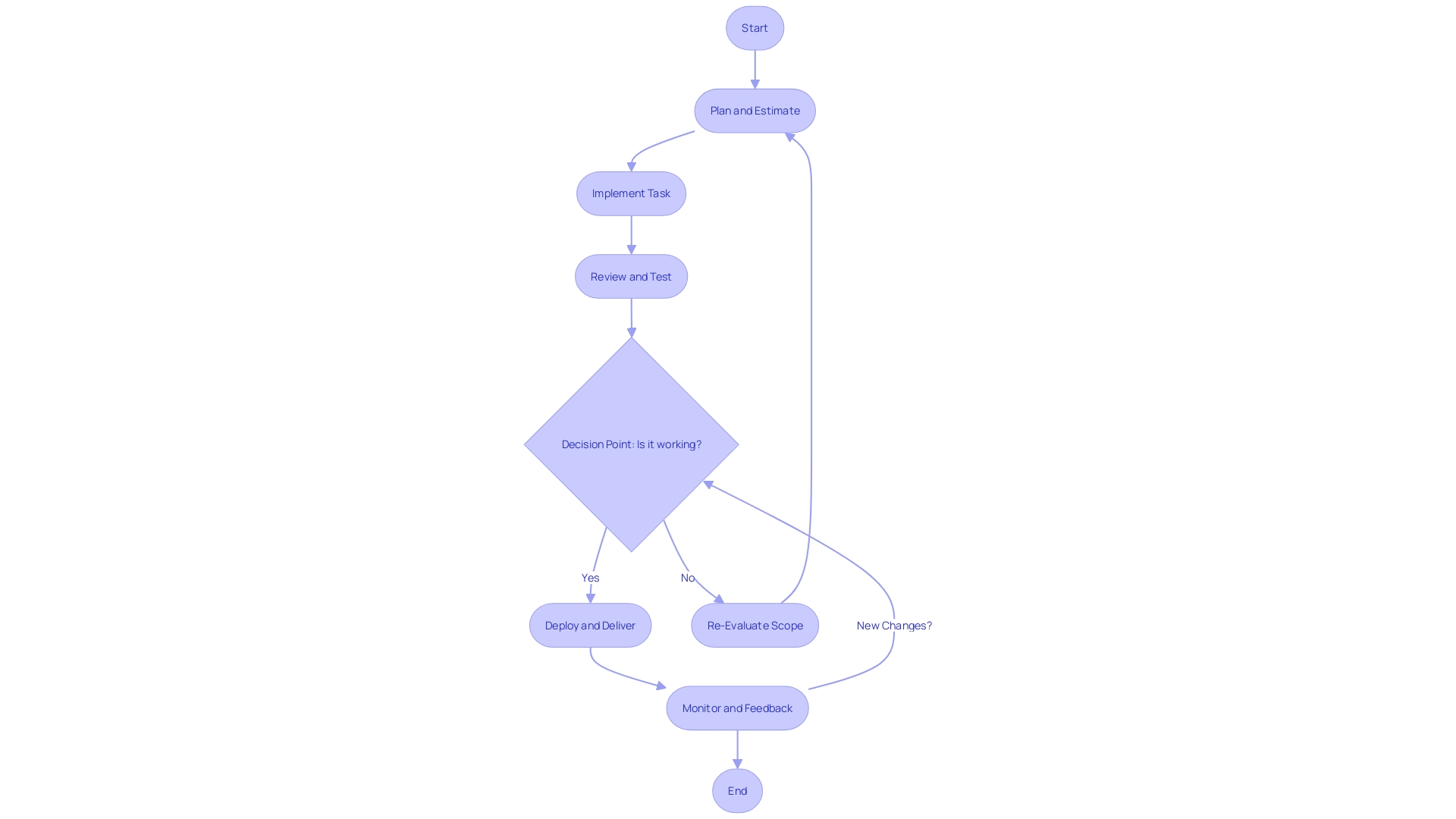
Measuring Success in Agile Development
Agile development methodologies prioritize adaptability and customer collaboration over rigid planning and protocols. A prime example of this philosophy in action is seen in the banking industry, where organizations like M&T Bank have faced the challenge of maintaining software quality while adapting to rapid digital transformations. To measure the success of their agile projects, banks must consider a variety of qualitative metrics beyond just on-time delivery and budget adherence.
One of the most critical KPIs in software development is customer satisfaction. It's a direct reflection of how well the software meets user needs and expectations. This is particularly vital in the banking sector, where trust and reliability are paramount, and any software issues can lead to significant reputational damage.
M&T Bank's initiative to establish Clean Code standards is an example of a qualitative metric aimed at ensuring customer satisfaction by maintaining high-quality, secure, and efficient software.
Another crucial metric is team velocity, which measures the amount of work a team can complete in a given timeframe. It's important to note that velocity is not just about speed but also about the quality and sustainability of the development process. The agile principle of 'working software is the primary measure of progress,' as stated in the Manifesto for Agile Software Development, underscores the importance of maintaining a balance between rapid iterations and producing robust, functional software.
Lastly, quality metrics such as code maintainability, security, and performance are indispensable, especially in industries with stringent regulatory requirements. M&T Bank's focus on Clean Code standards aligns with this need, as it minimizes maintenance time and costs while ensuring software reliability.
In conclusion, agile development requires a nuanced approach to KPIs, blending traditional measures with qualitative metrics that reflect the unique goals and challenges of each project. By doing so, organizations can truly harness the benefits of agility, achieving not just faster delivery times but also higher productivity, better financial outcomes, and improved customer satisfaction.
Tips for Mastering Agile Development
Agile development has revolutionized the way software is created, emphasizing flexibility, practicality, and efficiency. To truly master Agile practices, it's crucial for software teams to focus on fostering teamwork, embracing continuous improvement, managing project scope, and ensuring stakeholder engagement.
Teams can bolster their Agile proficiency by adopting an iterative development approach, dividing projects into manageable sprints that allow for regular inspection and adaptation. This method mirrors the practices seen in the early 2000s when Agile was first formulated, with a focus on delivering software rapidly through breaking projects into smaller elements and embracing change even at late stages.
A key to Agile success is empowering team members. By delegating authority and responsibility to specialists and minimizing top management's involvement, teams can harness the on-the-ground knowledge of developers. This aligns with the insights from JetBrains and GitKraken's State of Git Collaboration Report, which highlights the importance of team cohesion and efficiency.
Moreover, studies by Harvard professor Richard Hackman and colleague Neil Vidmar suggest that the optimal team size is between four to five members, striking a balance between collaboration and manageability.
Another Agile principle is to welcome learning from all team members, regardless of seniority. Junior developers can gain insights into coding standards and complex problem-solving from their more experienced peers, while senior developers stay abreast of new technologies through fresh perspectives from recent graduates. The practice of pair programming exemplifies this learning ethos, with one developer 'driving' while others provide guidance, fostering a culture of continuous learning and questioning the status quo.
Finally, maintaining an effective 'operating system' for team collaboration is essential. This system should outline how teams create value, what they aim to achieve, the technical skills required, the management processes, and the cultural norms for constructive collaboration. As Agile and Scrum continue to shape project management landscapes, it's clear that these methodologies' flexibility and adaptability are invaluable for modern software development teams.
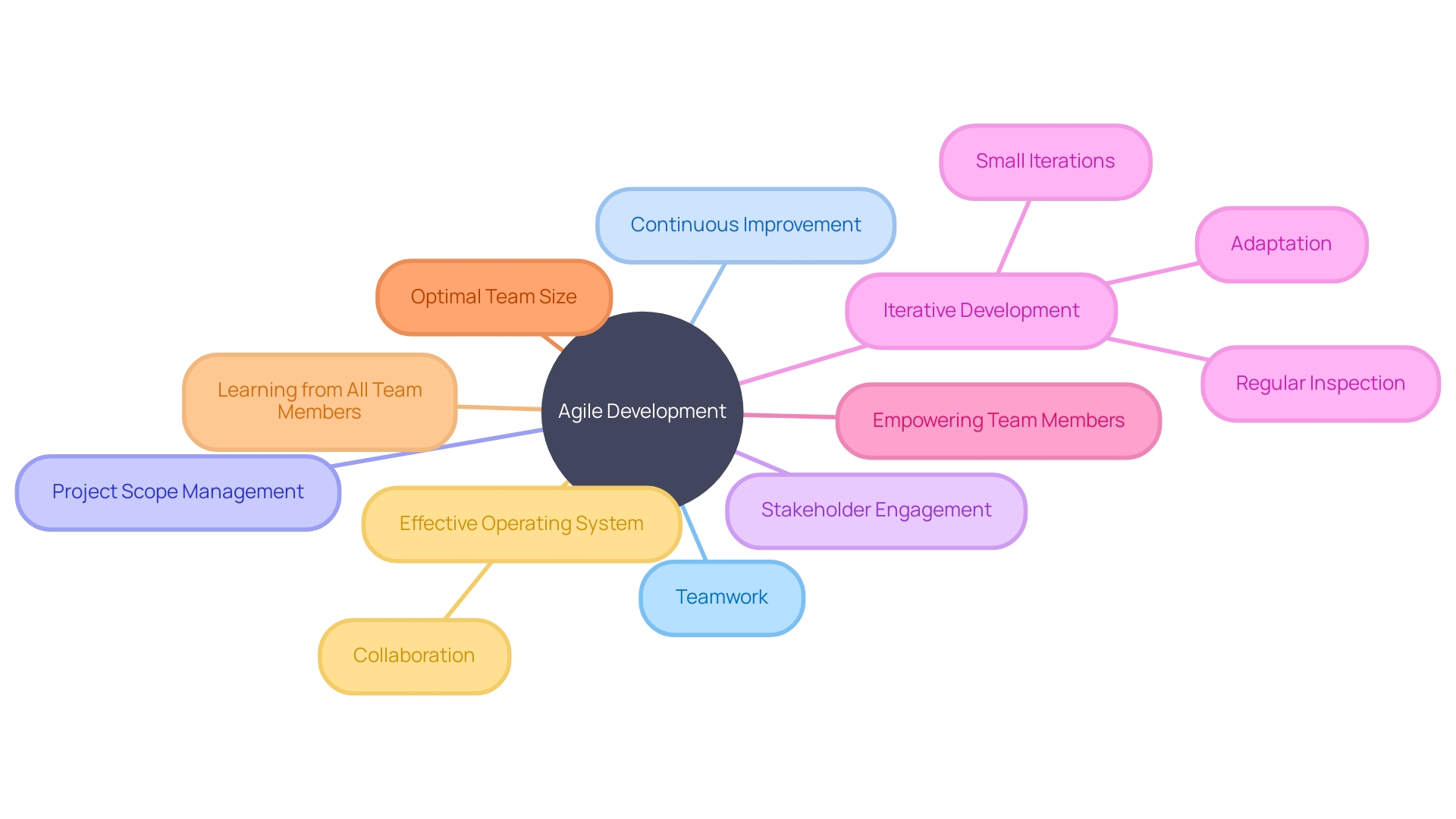
Conclusion
In conclusion, Agile development has revolutionized the software industry by prioritizing adaptability, collaboration, and continuous improvement. Agile methodologies like Scrum, Kanban, and Extreme Programming offer diverse frameworks for implementing Agile principles. Selecting the right methodology is crucial for project success.
Embracing an Agile mindset goes beyond project management techniques; it involves embracing change and continuous learning. Effective communication is essential in Agile development, fostering collaboration and successful project outcomes. Agile development relies on frequent iterations and feedback loops to ensure customer requirements are met.
Implementing Agile practices requires flexibility, adaptability, and a cultural shift within the organization. Measuring success in Agile development involves considering qualitative metrics like customer satisfaction and team velocity.
To master Agile development, teams should focus on fostering teamwork, embracing continuous improvement, managing project scope, and ensuring stakeholder engagement. By adopting an iterative approach and empowering team members, the benefits of Agile development can be harnessed.
In summary, Agile development offers a transformative mindset that prioritizes adaptability, collaboration, and continuous improvement. By embracing Agile principles and selecting the right methodology, software teams can navigate the complexities of modern development with agility and efficiency, delivering high-quality solutions.





